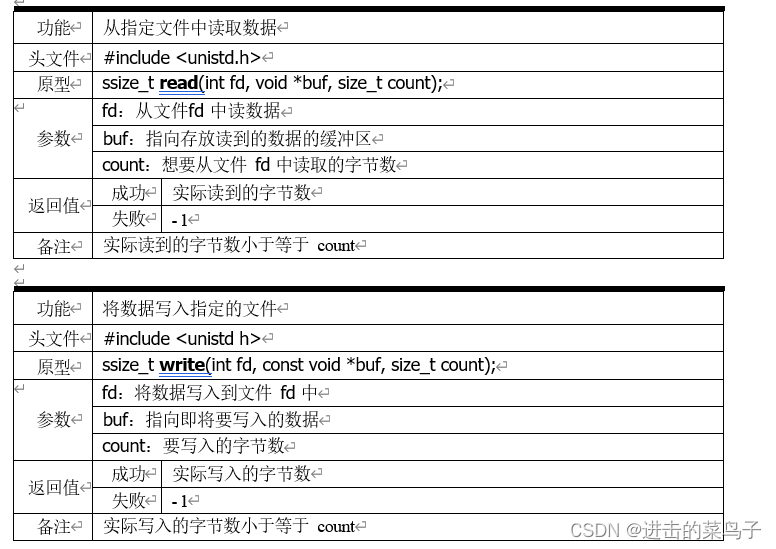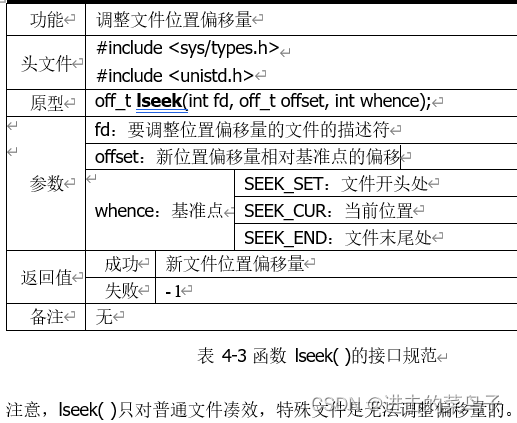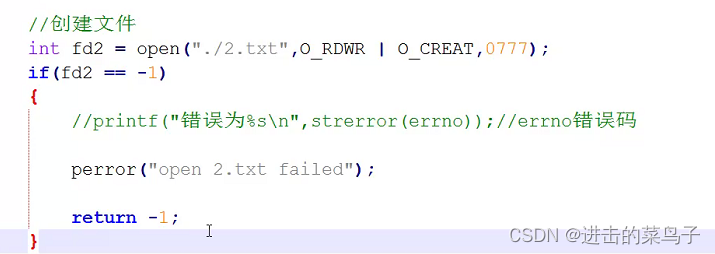Linux下的文件IO之系统IO
1. 知识点
读入写出,切记以我们程序为中心向文件或者别的什么东西读入写出(输入流输出流)
人话就是
文件向我们程序就是读入
程序向文件或者别的什么就是写出

2. open打开文件

open.c
/*************************************************************************
> File Name: open.c
> Author: lsf
> Mail: lsf_2012@163.com
> Created Time: 2023年10月20日 星期五 10时30分06秒
************************************************************************/
#include<stdio.h>
#include<unistd.h>
#include<sys/types.h>
#include<sys/stat.h>
#include<fcntl.h>
//使用open函数
int main()
{
//打开文件---1.txt文件存在
int fd1 = open("./1.txt",O_RDWR);
//创建文件
int fd2 = open("./2.txt",O_RDWR | O_CREAT,0777);
printf("fd1 = %d fd2 = %d\n",fd1,fd2);
//关闭文件
close(fd1);
close(fd2);
return 0;
}
3. read读入文件

read.c
#include<stdio.h>
#include<unistd.h>
#include<sys/types.h>
#include<sys/stat.h>
#include<fcntl.h>
#include<string.h>
//使用read函数
int main()
{
//打开文件---1.txt文件存在
int fd1 = open("./1.txt",O_RDWR);
char buf[10]={0};
//读文件
while(1){
memset(buf,0,sizeof(buf));//清空缓存区
ssize_t ret = read(fd1,buf,sizeof(buf)-1);
printf("%s",buf);
if(ret==0){
break;
}
}
//关闭文件
close(fd1);
return 0;
}
3.2 实现cat函数
cat.c
#include <sys/types.h>
#include <sys/stat.h>
#include <fcntl.h>
#include <stdio.h>
#include <unistd.h>
#include <string.h>
//自己写一个cat函数
int main(int argc, char **argv)//cat.out 1.txt 2.txt 3.txt 4.txt
{ //argv[0] argv[1] argv[2]
if(argc == 1)
{
printf("请给我至少一个文件的路径\n");
return 0;
}
int i;
for(i=1;i<argc;i++)
{
int fd1 = open(argv[i],O_RDWR);
char buf[10] = {0};
while(1)
{
memset(buf,0,sizeof(buf));//内存重置,清空bzero(buf,sizeof(buf));
ssize_t n = read(fd1,buf,sizeof(buf)-1);
printf("%s",buf);
//退出条件
if(n == 0)
{
close(fd1);
break;
}
}
}
}
4. write写出文件
write.c
#include<stdio.h>
#include<unistd.h>
#include<sys/types.h>
#include<sys/stat.h>
#include<fcntl.h>
#include<string.h>
//使用write函数实现文件的复制
int main()
{
int fd1 = open("./1.txt",O_RDONLY);
int fd2 = open("./2.txt",O_WRONLY|O_CREAT,0777);
char buf[10];
//文件的复制
while(1){
//内存清空
memset(buf,0,sizeof(buf));
//读文件
ssize_t n = read(fd1,buf,sizeof(buf)-1);
//写文件
write(fd2,buf,strlen(buf));
if(n==0){
close(fd1);
close(fd2);
break;
}
}
return 0;
}
5. lseek光标函数

lseek.c
#include<stdio.h>
#include<unistd.h>
#include<sys/types.h>
#include<sys/stat.h>
#include<fcntl.h>
#include<string.h>
//使用lseek函数
int main()
{
int fd1 = open("./4.txt",O_RDWR|O_CREAT,0777);
char buf[12] = "hello world";
char buf2[12];
//写文件
write(fd1,buf,strlen(buf));
lseek(fd1,0,SEEK_SET);//使光标复位到起始为止
//读文件
memset(buf2,0,sizeof(buf2));//清空缓存区
read(fd1,buf2,sizeof(buf2));
printf("%s\n",buf2);
close(fd1);
return 0;
}
6. perror错误打印函数

7. 练习
7.1 自我实现多个文件一起复制 copy函数
my_copy.c
#include<stdio.h>
#include<unistd.h>
#include<sys/types.h>
#include<sys/stat.h>
#include<fcntl.h>
#include<string.h>
//自我实现copy函数
int main(int argc, char **argv)
{
if(argc == 1)
{
printf("请给我至少一个文件的路径\n");
return 0;
}
int i=0;
for(i=1;i<argc;i+=2){
int fd1 = open(argv[i],O_RDONLY);
int fd2 = open(argv[i+1],O_WRONLY|O_CREAT,0777);
char buf[12];
//文件的复制
while(1){
//内存清空
memset(buf,0,sizeof(buf));
//读文件
ssize_t n = read(fd1,buf,sizeof(buf)-1);
//写文件
write(fd2,buf,strlen(buf));
if(n==0){
close(fd1);
close(fd2);
break;
}
}
}
return 0;
}
7.2 自我实现两个文件的比较diff函数
#include<stdio.h>
#include<unistd.h>
#include<sys/types.h>
#include<sys/stat.h>
#include<fcntl.h>
#include<string.h>
//自我实现diff函数
int main(int argc,char** argv)
{
if(argc == 1)
{
printf("请给我至少一个文件的路径\n");
return 0;
}
//打开两个文件
int fd1 = open(argv[1],O_RDONLY);
int fd2 = open(argv[2],O_RDONLY);
char buf1[5] = {0};
char buf2[5] = {0};
int flag = 0;//两文件相同
while(1){
//读取文件
memset(buf1,0,sizeof(buf1));
memset(buf2,0,sizeof(buf2));
ssize_t n1 = read(fd1,buf1,sizeof(buf1)-1);
ssize_t n2 = read(fd2,buf2,sizeof(buf2)-1);
//比较读取出来的buf
if(strcmp(buf1,buf2)!=0){
flag = 1;//不同
break;
}
if(n1==0){
close(fd1);
break;
}
if(n2==0){
close(fd2);
break;
}
}
//至此
if(flag){
printf("两个文件不同\n");
}else{
printf("两文件相同\n");
}
return 0;
}
